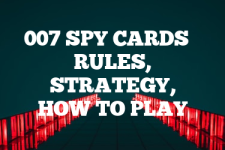Wixoss Collectible Card Game: A Player’s Guide to Cards, Strategy & Play Instructions
Introduction
Wixoss is a complex collectible card game that has been capturing the interest of players since its release. It’s a game that combines strategy, luck, and a bit of psychological warfare. The game was first released in Japan in 2014 and has since seen various expansions and related media, including an anime series. Wixoss stands out because it’s not just about having powerful cards, but also about how you use them. The game is still in print, with new sets and cards being released regularly, keeping the game fresh and exciting for both new and experienced players.

Quick Tip for Wixoss
Always keep an eye on your opponent’s SIGNI zone; it can give you clues about their strategy.
Rules for playing Wixoss
Understanding the rules of Wixoss is key to playing the game well. The game is played between two players, each with a deck of 40 cards. The main goal is to attack your opponent’s Life Cloth cards and reduce them to zero. Each player starts with a deck, a LRIG (the main character card), and five Life Cloth cards. Players take turns drawing cards, growing their LRIG, summoning SIGNI creatures to the field, and attacking the opponent. There are also spells and ARTS that can turn the tide of the game. The game ends when one player has no Life Cloth cards left or cannot draw a card from their deck.
Card Types for Wixoss
There are several types of cards in Wixoss:
- LRIG: Your avatar in the game, which you use to attack and defend.
- SIGNI: Creatures you summon to the field to protect your LRIG and attack your opponent.
- Spell: Cards that have various effects like drawing more cards or destroying opponent’s SIGNI.
- ARTS: Powerful abilities that can only be used once per turn.
- Life Cloth: Cards that represent your life points in the game.
Starter sets are available for new players, which provide a balanced deck to learn the game.
How to Play Wixoss and Game Mechanics
The game starts with each player drawing five cards. You can grow your LRIG by placing a card from your hand into the LRIG zone if it’s the next level. You can summon SIGNI to the field to attack and defend. Each turn, you can use one ARTS and cast any number of spells. The game progresses through a series of turns where players attack, defend, and use their cards’ abilities until one player wins.
How to Win at Wixoss
Winning at Wixoss requires a mix of strategy, understanding of the game mechanics, and a bit of luck. Beginners should focus on learning the card effects and when to use them. Intermediate players can start to predict their opponent’s moves and plan accordingly. Advanced players will have a deep understanding of the meta, the most powerful card combinations, and will be able to adapt their strategy on the fly.
Best Strategies for playing Wixoss
The best strategies in Wixoss involve knowing your deck inside out, understanding the current meta, and being able to read your opponent. Some strategies include controlling the field with powerful SIGNI, using spells and ARTS to disrupt your opponent’s plans, and knowing when to attack and when to hold back. Sneaky tactics might involve bluffing about the cards in your hand or setting traps with your spells and ARTS.
Here are some general strategies that I recommend to excel in Wixoss:
1. Understand the Rules Thoroughly: Before devising any strategies, make sure you have a complete understanding of the game’s rules, phases, and card interactions. This foundational knowledge enables you to exploit game mechanics and avoid mistakes.
2. Deck Building Skills: A well-constructed deck is key to success. Consider the balance of card types, such as SIGNI, spells, and LRIG, and ensure you have a good mix of offensive, defensive, and utility cards. Pay attention to the synergy between cards to maximize their effectiveness.
3. Resource Management: Like in many card games, managing resources (such as Life Cloth, Ener Zone, and your hand) is crucial. Ensure you’re making efficient use of your resources and not overextending yourself, leaving you vulnerable to counterplays.
4. Know Your Win Conditions: Have a clear idea of how your deck is supposed to win the game, whether it’s through direct attacks, controlling the board, or a specific card combo. Focus your strategy around achieving this condition.
5. Adaptability: Be prepared to adapt your playstyle based on your opponent’s actions. If you’re too rigid in your strategy, you may be easily countered. Flexibility can often lead to victory.
6. Meta Knowledge: Keep up with the competitive scene and know what decks are currently strong (the “meta”). Understanding popular strategies can help you prepare counters to them or improve your own deck.
7. Practice Makes Perfect: Play as many games as possible to get a feel for different matchups and scenarios. The more you play, the better you’ll understand the flow of the game and how to react to various situations.
8. Mulligan Wisely: Learning when to keep a hand and when to take a mulligan is crucial. You want a starting hand that allows for a strong opening play and sets up your strategy.
9. Anticipate Your Opponent: Try to predict your opponent’s moves and have a counter ready. Being one step ahead can disrupt their plans and give you an advantage.
10. Card Advantage: Work to maintain card advantage over your opponent, which often translates into more options and more control over the game. This can be achieved through effects that draw cards, recycle cards from the trash, or disrupt the opponent’s hand.
11. Control the Pace: Dictate the flow of the game. If your deck excels at late-game scenarios, focus on survival and control. If it’s more aggressive, push for an early win before your opponent can set up their strategy.
12. Risk Assessment: Weigh the risks and benefits of each play. Sometimes, a high-risk move can win you the game, but it’s important to know when to take those chances.
13. Watch and Learn: Observe matches between skilled players, either in person or online. This can give you insights into advanced strategies and tactics that you can incorporate into your own gameplay.
14. Psychological Play: Mind games can be a part of any competitive game. Learn to read your opponent and use misdirection or bluffing to your advantage.
15. Stay Updated: Wixoss introduces new expansions or rules changes, so stay informed and adapt your strategies accordingly. The most successful players are often those who can quickly adjust to the evolving game landscape.
Deck Building and Best Cards
Building a good deck in Wixoss is about balance and synergy. You want a mix of LRIG, SIGNI, spells, and ARTS that work well together. It’s also important to have a strategy in mind when building your deck.
Best Cards in Wixoss
- Code Anti Nihonium: A powerful LRIG that can disrupt your opponent’s strategy.
- Code Art BABYDOLL: A spell card that offers great control options.
- Code Order: A versatile ARTS card that can turn the tide of the game.
Scenarios
Good scenarios in Wixoss are when you have control of the field and can predict your opponent’s moves. Bad scenarios might be when you’re low on Life Cloth or have a poor hand. In both cases, it’s important to stay calm and think strategically about how to turn the situation to your advantage.
Frequently Asked Questions about playing Wixoss game
Q: How many cards can I have in my hand?
A: There is no limit to the number of cards you can have in your hand.
Q: Can I change my LRIG during the game?
A: Yes, you can grow your LRIG by leveling up during the game.
Q: What happens if I run out of cards in my deck?
A: If you cannot draw a card because your deck is empty, you lose the game.
Additional Subtopics
Other things to consider when playing Wixoss include the timing of your moves, the pace of the game, and managing your resources. It’s also important to keep up with new card releases and changes in the game’s rules.
External Links
For more information on Wixoss, check out the Wikipedia page or the official Wixoss website.

Eve Brownlee was a gamer before gaming communities on the internet were a thing. Eve grew up playing traditional, standard deck card games like Rummy and Bezique, taking an interest in the classics Backgammon and Chess. Parlor card games like Bridge continue to keep Eve active in the community. After a long career, primarily in horticulture for USDA in Maryland, Eve now travels and writes on The Pineapple (pineapples.info) and contributes to Quora/Pinterest topics. Contact Eve via email.



